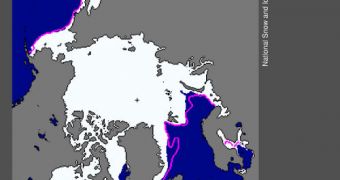According to the latest monthly report by the US National Snow and Ice Data Center (NSIDC), it would appear that the ice extent in the Arctic throughout February was the lowest in satellite history, on part with readings collected in 2005.
Interestingly, while the North Pole was covered by less ice than ever before on record, winter snow covers remained extensive throughout the Northern Hemisphere. Canada, Russia, northern Europe and the United States were especially hard-hit by the snowstorms.
Sea ice extents last month were particularly low in the Labrador Sea and Gulf of St. Lawrence, which were supposed to be covered during this time. The ices covered only 14.36 million square kilometers (5.54 million square miles).
The NSIDC reports show that the low ice extent affected both the Atlantic and Pacific sectors of the Arctic, hinting that the phenomena at work in prompting this state of affairs act on the entire region.
One of the possible explanations for this is the warming Arctic Ocean. Temperatures in the water were between 2 and 4 degrees Celsius (4 and 7 degrees Fahrenheit) higher than normal, experts indicate.
Additionally, the team discovered that the East Greenland Sea and the regions northwards of that location were subjected to air temperatures that were 5 to 7 degrees Celsius (9 to 13 degrees Fahrenheit) above normal.
If we take into account February 2011 too, then the melting trend of the Arctic becomes even clearer. The North Pole is losing ice at a rate of -3.0 percent every decade. This level of loss is alarming, and the bad news is that it's being kept up by a feedback loop.
“Through most of January, the Arctic Oscillation (AO) was generally in a strongly negative phase, similar to the pattern that dominated the winter of 2009 to 2010,” the NSIDC report shows.
“This led to very warm temperatures over the eastern Arctic, helping to account for the low ice extents over the Labrador Sea and Gulf of Saint Lawrence,” the document goes on to reveal.
“Reduced sea ice extent and extensive snow cover are not contradictory, and are both linked to a strong negative phase of the Arctic Oscillation,” the report explains. Some climate change deniers have used this argument to try and persuade less-educated people in their favor.

 14 DAY TRIAL //
14 DAY TRIAL //